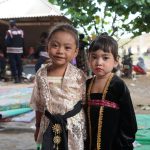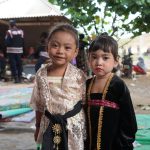The Navajo people, known as the Diné, are one of the largest Native American tribes in the United States, with a rich cultural heritage that spans centuries. Their ancestral lands, known as the Navajo Nation, encompass parts of Arizona, New Mexico, and Utah, covering over 27,000 square miles of diverse landscapes that range from arid deserts to mountainous regions. The Navajo have a profound connection to their land, which is not merely a backdrop for their lives but a living entity that shapes their identity, spirituality, and way of life.
This deep-rooted relationship with the environment is reflected in their traditions, stories, and practices, which emphasize harmony with nature and respect for all living things. Historically, the Navajo people have faced numerous challenges, including forced relocation during the Long Walk in the 1860s, which resulted in significant loss of life and cultural dislocation. Despite these adversities, the Diné have demonstrated remarkable resilience and adaptability.
They have preserved their language, customs, and beliefs while also integrating aspects of modern society. Today, the Navajo Nation is a vibrant community that continues to thrive, balancing traditional practices with contemporary influences. The Navajo people are not only custodians of their rich heritage but also active participants in the broader American narrative, contributing to art, politics, and social movements while maintaining a strong sense of identity rooted in their ancestral traditions.
Key Takeaways
- The Navajo people are a Native American tribe with a rich cultural heritage and history.
- Traditional Navajo art and craftsmanship include intricate jewelry making, weaving, and pottery.
- The Navajo language is an important part of their oral traditions, which are passed down through storytelling and songs.
- Navajo cuisine features traditional dishes such as frybread, mutton stew, and blue corn mush.
- Navajo music and dance are integral to their cultural and spiritual practices, often performed during ceremonies and gatherings.
Traditional Navajo Art and Craftsmanship
Navajo art and craftsmanship are celebrated for their intricate designs and deep cultural significance. Among the most renowned forms of Navajo art is weaving, particularly the creation of rugs and blankets that showcase stunning geometric patterns and vibrant colors. These textiles are not merely decorative; they serve practical purposes and are often imbued with spiritual meanings.
The art of weaving is traditionally passed down through generations, with each piece telling a story or representing a specific aspect of Navajo life. The use of natural dyes derived from plants and minerals further connects these creations to the land, reflecting the Navajo philosophy of living in harmony with nature. In addition to weaving, Navajo silversmithing has gained international acclaim for its craftsmanship and artistry.
The introduction of silver to the Navajo community in the 19th century led to a flourishing tradition of jewelry-making that combines traditional techniques with contemporary designs. Turquoise, a stone deeply revered by the Navajo for its protective qualities and connection to the earth, is often featured prominently in their jewelry. Each piece is not only an expression of beauty but also a representation of cultural identity and personal stories.
The artistry involved in both weaving and silversmithing highlights the Navajo commitment to preserving their heritage while embracing innovation, ensuring that their artistic expressions remain relevant in today’s world.
Navajo Language and Oral Traditions

The Navajo language, or Diné Bizaad, is a vital component of the tribe’s cultural identity and serves as a vehicle for transmitting knowledge, history, and values across generations. As a complex and nuanced language belonging to the Athabaskan family, Diné Bizaad is characterized by its rich vocabulary and intricate grammatical structures. The preservation of this language is crucial not only for maintaining cultural continuity but also for fostering a sense of belonging among the Navajo people.
Efforts to revitalize the language have gained momentum in recent years through educational programs and community initiatives aimed at teaching younger generations the importance of their linguistic heritage. Oral traditions play an equally significant role in the Navajo culture, serving as a means of storytelling that conveys moral lessons, historical events, and spiritual beliefs. These narratives often feature prominent figures from Navajo mythology and reflect the tribe’s deep connection to the land and its resources.
Elders are revered as keepers of knowledge, sharing stories that encapsulate the wisdom of past generations while reinforcing communal values such as respect for nature and kinship. Through storytelling, the Navajo people not only preserve their history but also instill a sense of pride in their identity. This oral tradition fosters a communal bond that transcends time, ensuring that the teachings of the past continue to resonate within contemporary society.
Navajo Cuisine and Culinary Traditions
| Traditional Navajo Dish | Ingredients | Cooking Method |
|---|---|---|
| Frybread | Flour, salt, baking powder, water | Deep-fried in oil |
| Blue Corn Mush | Blue cornmeal, water, salt | Cooked on stovetop |
| Navajo Tacos | Frybread, ground beef, lettuce, tomatoes, cheese, salsa | Assembling ingredients on frybread |
| Mutton Stew | Mutton, potatoes, carrots, onions, salt, water | Cooked in a pot over a fire |
Navajo cuisine is a reflection of the tribe’s deep connection to the land and its resources, characterized by traditional ingredients and cooking methods that have been passed down through generations. Central to this culinary tradition is corn, which holds significant cultural importance for the Navajo people. Corn is not only a staple food but also symbolizes life and sustenance in many Native American cultures.
Dishes such as frybread—a deep-fried flatbread—have become iconic representations of Navajo cuisine, often served at gatherings and celebrations. Frybread can be enjoyed plain or topped with various ingredients like honey or beans, showcasing its versatility as both a comfort food and a communal dish. In addition to corn-based dishes, traditional Navajo cuisine incorporates a variety of meats, vegetables, and herbs sourced from the surrounding environment.
Lamb is particularly favored in many recipes, reflecting both historical practices and contemporary preferences. The preparation of meals often involves communal efforts where families come together to cook and share food, reinforcing social bonds within the community. Furthermore, seasonal changes influence culinary practices; for instance, summer harvests bring fresh produce that enhances traditional recipes.
Through these culinary traditions, the Navajo people celebrate their heritage while adapting to modern influences, ensuring that their food culture remains vibrant and relevant.
Navajo Music and Dance
Music and dance are integral aspects of Navajo culture, serving as expressions of identity, spirituality, and community cohesion. Traditional Navajo music encompasses a wide range of styles and instruments, including drums, flutes, and rattles. Songs often accompany ceremonies or rituals that mark significant life events such as births, weddings, or healing ceremonies.
The melodies are deeply rooted in the tribe’s spiritual beliefs and are believed to connect individuals with their ancestors and the natural world. Through music, the Navajo people convey stories of creation, resilience, and harmony with nature, reinforcing their cultural values while fostering a sense of belonging. Dance is equally important in Navajo culture, often performed during ceremonies or community gatherings to celebrate significant occasions or honor spiritual beliefs.
The movements are not merely artistic expressions; they embody stories and teachings passed down through generations. Dancers often wear traditional regalia adorned with symbols that represent their clan or family lineage. These performances serve as a means of cultural preservation while also providing an opportunity for younger generations to engage with their heritage actively.
In contemporary settings, Navajo music and dance continue to evolve while remaining rooted in tradition, showcasing the tribe’s adaptability and commitment to preserving their cultural legacy.
Navajo Clothing and Fashion

Traditional Navajo clothing reflects both practicality and artistry, showcasing intricate designs that carry cultural significance. Historically, clothing was made from natural materials such as wool from sheep raised by the Navajo people or cotton grown in their fields. Women traditionally wore long dresses known as “navajo dresses,” often adorned with colorful patterns that symbolize various aspects of life within the tribe.
Men typically wore shirts made from woven fabric paired with trousers or breechcloths. The clothing not only served functional purposes but also conveyed social status and clan affiliation through specific colors and designs. In contemporary times, while many Navajo individuals embrace modern fashion trends, there remains a strong appreciation for traditional attire during ceremonies and cultural events.
The blending of traditional elements with modern styles has given rise to unique fashion statements that honor heritage while allowing for personal expression. Designers within the Navajo community are increasingly gaining recognition for their innovative approaches to fashion that incorporate traditional motifs into contemporary clothing lines. This fusion not only celebrates cultural identity but also challenges stereotypes about Native American fashion by showcasing its dynamic nature in today’s world.
Navajo Religious and Spiritual Practices
Navajo religious beliefs are deeply intertwined with their understanding of nature and the cosmos. Central to these beliefs is the concept of hózhóó—often translated as harmony or balance—which emphasizes living in accordance with natural laws and maintaining equilibrium within oneself and one’s environment. The Diné view themselves as part of a larger interconnected web of life where every element has its place and purpose.
This worldview informs various spiritual practices that seek to restore balance when disrupted by illness or misfortune through ceremonies such as healing rituals or blessings. Ceremonial practices play an essential role in maintaining spiritual health within the community. These rituals often involve elaborate songs, prayers, dances, and offerings made to deities or spirits believed to influence daily life.
The Blessingway ceremony is one such important ritual that celebrates significant life transitions while invoking protection from negative forces. Elders serve as spiritual leaders who guide participants through these ceremonies with wisdom rooted in tradition. By engaging in these practices collectively as a community rather than individually alone—Navajos reinforce social bonds while nurturing their spiritual well-being amidst modern challenges they face today.
In conclusion, exploring various facets of Navajo culture reveals a rich tapestry woven from history, tradition, resilience, artistry—and above all—a profound connection to land that shapes every aspect of life for this remarkable people known as Diné.
If you’re interested in exploring more about cultural identification and its implications, you might find the article on the terms of use page quite enlightening. It discusses various aspects of how cultural norms and practices are integrated into digital platforms, which can significantly influence user interaction and engagement. For a deeper understanding, you can read the full article by visiting Terms of Use at APEAI. This resource provides valuable insights into the legal and cultural frameworks that shape our online experiences.
FAQs
What is cultural identification?
Cultural identification refers to the process of identifying with and feeling a sense of belonging to a particular cultural group or community. It involves adopting the values, beliefs, customs, and traditions of that culture.
Why is cultural identification important?
Cultural identification is important as it helps individuals develop a sense of belonging, self-esteem, and identity. It also plays a crucial role in shaping one’s worldview, behavior, and interactions with others.
How does cultural identification impact individuals?
Cultural identification can impact individuals in various ways, including influencing their sense of self, shaping their values and beliefs, and impacting their relationships with others. It can also affect their experiences of discrimination and marginalization.
What factors influence cultural identification?
Factors that influence cultural identification include family background, upbringing, social environment, exposure to different cultures, and personal experiences. Additionally, historical and societal factors can also play a role in shaping cultural identification.
Can individuals identify with multiple cultures?
Yes, individuals can identify with multiple cultures, a phenomenon known as bicultural or multicultural identity. This can occur when individuals have connections to more than one cultural group, such as through family heritage, upbringing, or lived experiences.









